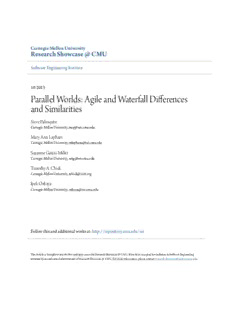
Parallel Worlds: Agile and Waterfall Differences and Similarities PDF
Preview Parallel Worlds: Agile and Waterfall Differences and Similarities
Carnegie Mellon University Research Showcase @ CMU Software Engineering Institute 10-2013 Parallel Worlds: Agile and Waterfall Differences and Similarities Steve Palmquist Carnegie Mellon University, [email protected] Mary Ann Lapham Carnegie Mellon University, [email protected] Suzanne Garcia-Miller Carnegie Mellon University, [email protected] Timothy A. Chick Carnegie Mellon University, [email protected] Ipek Ozkaya Carnegie Mellon University, [email protected] Follow this and additional works at:http://repository.cmu.edu/sei This Article is brought to you for free and open access by Research Showcase @ CMU. It has been accepted for inclusion in Software Engineering Institute by an authorized administrator of Research Showcase @ CMU. For more information, please [email protected]. Parallel Worlds: Agile and Waterfall Differences and Similarities M. Steven Palmquist Mary Ann Lapham Suzanne Miller Timothy Chick Ipek Ozkaya October 2013 TECHNICAL NOTE CMU/SEI-2013-TN-021 Software Solutions Division http://www.sei.cmu.edu Copyright 2013 Carnegie Mellon University This material is based upon work funded and supported by the Department of Defense under Contract No. FA8721-05-C- 0003 with Carnegie Mellon University for the operation of the Software Engineering Institute, a federally funded research and development center. Any opinions, findings and conclusions or recommendations expressed in this material are those of the author(s) and do not necessarily reflect the views of the United States Department of Defense. This report was prepared for the SEI Administrative Agent AFLCMC/PZE 20 Schilling Circle, Bldg 1305, 3rd floor Hanscom AFB, MA 01731-2125 NO WARRANTY. THIS CARNEGIE MELLON UNIVERSITY AND SOFTWARE ENGINEERING INSTITUTE MATERIAL IS FURNISHED ON AN “AS-IS” BASIS. CARNEGIE MELLON UNIVERSITY MAKES NO WARRANTIES OF ANY KIND, EITHER EXPRESSED OR IMPLIED, AS TO ANY MATTER INCLUDING, BUT NOT LIMITED TO, WARRANTY OF FITNESS FOR PURPOSE OR MERCHANTABILITY, EXCLUSIVITY, OR RESULTS OBTAINED FROM USE OF THE MATERIAL. CARNEGIE MELLON UNIVERSITY DOES NOT MAKE ANY WARRANTY OF ANY KIND WITH RESPECT TO FREEDOM FROM PATENT, TRADEMARK, OR COPYRIGHT INFRINGEMENT. This material has been approved for public release and unlimited distribution except as restricted below. Internal use:* Permission to reproduce this material and to prepare derivative works from this material for internal use is granted, provided the copyright and “No Warranty” statements are included with all reproductions and derivative works. External use:* This material may be reproduced in its entirety, without modification, and freely distributed in written or elec- tronic form without requesting formal permission. Permission is required for any other external and/or commercial use. Re- quests for permission should be directed to the Software Engineering Institute at [email protected]. * These restrictions do not apply to U.S. government entities. Carnegie Mellon®, CMMI® are registered in the U.S. Patent and Trademark Office by Carnegie Mellon University. Personal Software Process℠, TSP℠ are service marks of Carnegie Mellon University. DM-0000488 Table of Contents Executive Summary viii Abstract x Introduction xii 1 The Two Worlds—Traditional and Agile 1 1.1 Background 1 1.2 Waterfall Overview 3 1.3 Agile Overview 9 2 Similarities—The Same Basic Building Blocks 15 2.1 Similarities—Traditional and Agile Share the Same Goal 15 2.2 Similarities—The Traditional World and the Agile World Use Many of the Same Principles15 2.3 Similarities—The Traditional World and the Agile World Use the Same Basic Building Blocks 16 3 Differences—Significantly Different Perspectives 20 3.1 Differences—Forward-Looking Perspective vs. Backward-Facing Perspective 20 4 Differences—Terms and Concepts 21 4.1 Differences—The Traditional World and the Agile World Do Not Use the Same Words (Or If They Do, They Don’t Always Have the Same Meanings) 21 4.1.1 Agile World and Traditional World Terms 21 5 Summary 73 Appendix A Waterfall Software Development – DoD’s Misplaced Emphasis? 75 Appendix B History of Agile 81 References/Bibliography 84 CMU/SEI-2013-TN-021 | i CMU/SEI-2013-TN-021 | ii List of Figures Figure 1: Basic Representation of Waterfall Model 4 Figure 2: DAU Representation of Software Life Cycle 7 Figure 3: The System Development V 8 Figure 4: Agile Life Cycle 13 Figure 5: Requirements Moving En Masse Through the Process 17 Figure 6: Blocking and Increment Techniques 18 Figure 7: Agile Building Blocks 18 Figure 8: Royce Model #1 76 Figure 9: Royce Model #2 77 Figure 10: Royce Model #3 78 CMU/SEI-2013-TN-021 | iii CMU/SEI-2013-TN-021 | iv List of Tables Table 1: Agile Instantiations of Traditional Principles 16 CMU/SEI-2013-TN-021 | v CMU/SEI-2013-TN-021 | vi Acknowledgments The authors would like to thank John Hawrylak of the SEI for his insight reviewing this docu- ment. In addition, the authors would like to thank the following members of the Agile Collaboration Group for their suggestions, comments, and reviews: • Jennifer Walker (Raytheon Company) • Curtis Hibbs (The Boeing Company) • Richard Carlson (The Boeing Company) CMU/SEI-2013-TN-021 | vii
Description: